
|
||
|
Portland art blog + news + exhibition reviews + galleries + contemporary northwest art
|
||
Anything but artifacts: John Brodie + F&D Cartier In the Twentieth Century artists started obsessing about the life of objects like no time in history. It was a confluence of ideas from the East like, Buddhism, Shintoism, Taoism and Tahitian etc.. as they mixed with emerging late 19th century European ideas around property and industrialization. It created an anxiousness within very distinct world views that made a sense of the avant-garde possible.
With Kandinsky there was a sense of active engagement with the viewer akin to music, Kurt Schwitters turned stuff into an environment, Picasso and Braque used collage and eventually Robert Rauschenberg created combines to made art out of anything (we can credit Dada and Arte Povera too). These developments lead to a heightened sense that some objects had an active life as a presence or art and some became a precious artifacts, both venerated and dead. Of course there are many shades of gray in between the two polarities of active object and artifact and Art can be found along all spectrums. For example Carol Bove has used shelving to make collections of books and photographs into presentations of artifacts as Art. Before her intervention the books are simply material objects that can be activated by reading them... but in her case the art making is a privileging veneration that makes them unavailable. 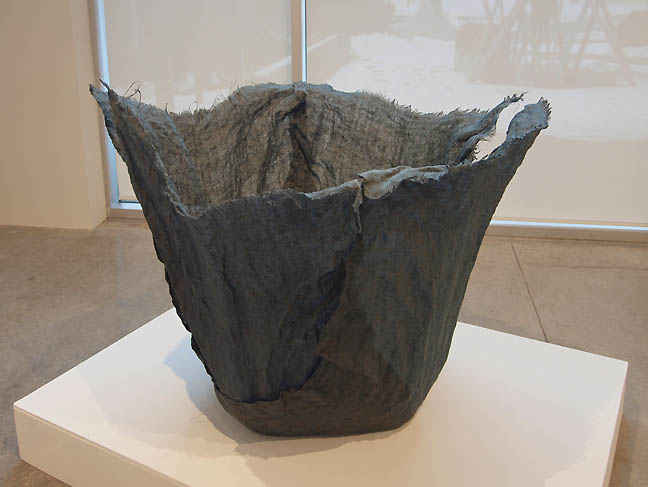 John Brodie's Blue Vessel at Linfield College This month, two exhibitions present a series compelling ruminations on art objects as artifacts and material with John Brodie's Versus Artifacts at Linfield College and F&D Cartier's Wait and See at Blue Sky. 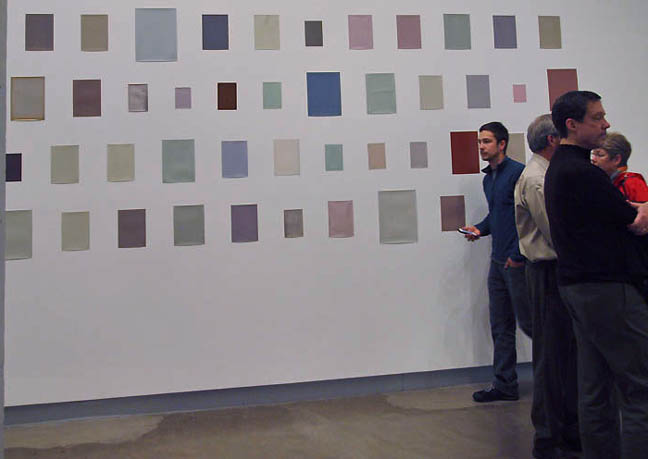 F&D Cartier's Wait and See at Blue Sky Artifacts are objects that acquire relevance, value and therefore protection over time, whereas art is authored by an artist. To play out that logic, not all artifacts are art but any art that survives the period in which it was made becomes an artifact of sorts. Also, the more precious the art is and the more removed from its originally intended display the more of an artifact it becomes. Thus, in general something becoming an artifact indicates a kind of survival and separation from its origins that is predicated on veneration. One could even say that the Pope or President of the United States ceases to become a private citizen through becoming an artifact of leadership roles and civics. This veneration of objects is a subject that has long held interest for artists and John Keats famous poem Ode to Grecian Urn, explored the way objects endure and became venerated. Later, artists in the 20th century like Duchamp, Donald Judd and Carl Andre sought to undermine reverence for artifacts. 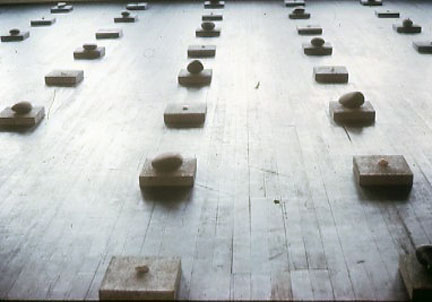 Carl Andre 144 Blocks & Stones, 1973 (Detail) Concrete blocks, found and store bought rocks and minerals Installed at the Portland Center for Visual Arts in March 1973 Image courtesy the PCVA Archive at the Portland Art Museum (c) Carl Andre 2008 In particular, Carl Andre made a career out of trying to keep his work from being artifacts (forbidding them being put in cases or on plinths which change them from rocks or brick materials into unavailable artifacts) and went so far as to allow viewers to walk on his floor pieces. When discussing artifacts it is precisely the interest that the object causes viewers in the present as to how it related to the past that creates value... it doesn't matter how common or trivial it was at the time it was minted or used but the way we filter and contextualize it in the present. Thus Grecian urns, which were once utilitarian became stand ins for an entire era of a civilization. The point is, there is value in inquiry and veneration but that value can damage ones appreciation of art (becoming so valuable that it is locked away from most eyes) or heighten it in the way 142 million dollars for Francis Bacon at the Portland Art Museum makes otherwise disinterested people pay attention to the work. Thus, the gaze or study gives an object value, while paradoxically the exhibition which allows that gaze also aids the entropy of that object or puts it at some risk. Fact is, all objects are at risk and that is partially why the accumulate other contextual information. 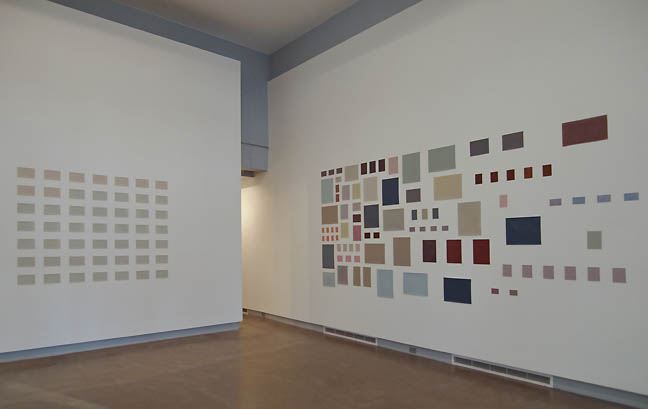 Wait and See at Blue Sky Within Portland's city limits, perhaps the best exhibition on display of this phenomena right is F&D Cartier's Wait and See at Blue Sky Gallery. The Swiss team have assembled an archive of various analog photographic paper on the walls. As such, It would be a museum to old school photographic material if it weren't for the fact that the paper is generally not identified by its type and properties and is displayed in a light reactive state.... quietly changing with the light which spills into the gallery. Thus, the work is an entropy sensor, aging in the light a little faster than we humans do. In essence the entire gallery has been transformed into a camera which imprints through photochemical activity and the opposite of a dark room or a protective archive. 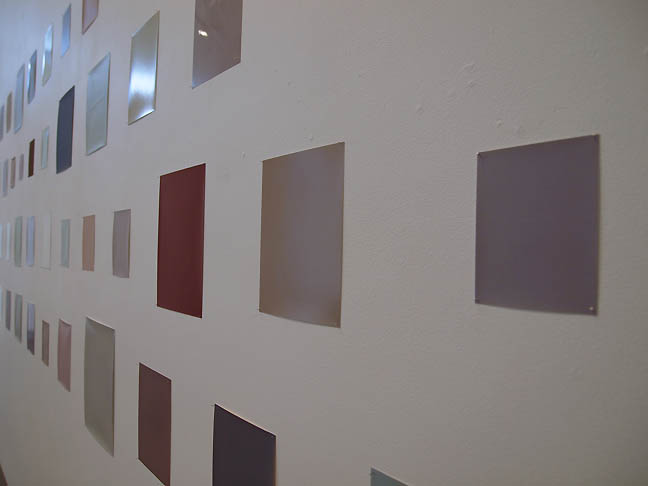
The exhibition is wonderfully laid out with one of the four walls being left blank. The two north and south walls are arranged with a variegated array of photo papers by Kodak, Sears and Roebuck, Lumiere & Jougla and Agfa Leverkusen, etc. The polyphony of the various rectangles is reminiscent of the great Swiss artist Paul Klee but the resulting liminograms (what the Cartiers call their exposed but not processed photographic papers) also recall everything from drying herbs a test facility where color swatches are compared for lightfastness. The resulting entropy is fascinating as the destruction of the paper's photo reactivity results in the work. Only one wall is filled with an array of the same off white papers giving it chapel like feel. For photography geeks this entire exhibition constitutes a shrine to once common tools of their trade but for me the entropy keeps things very present and this circumvention of nostalgia is compelling. It behaves in much in the same way a Donald Judd work is supposed to highlight the floor and the wall without really dwelling in or on one of the other wholly. Here, F&D Cartier have cheated an archive, making it very present, beautiful and in the peril of the moment we gaze upon it. 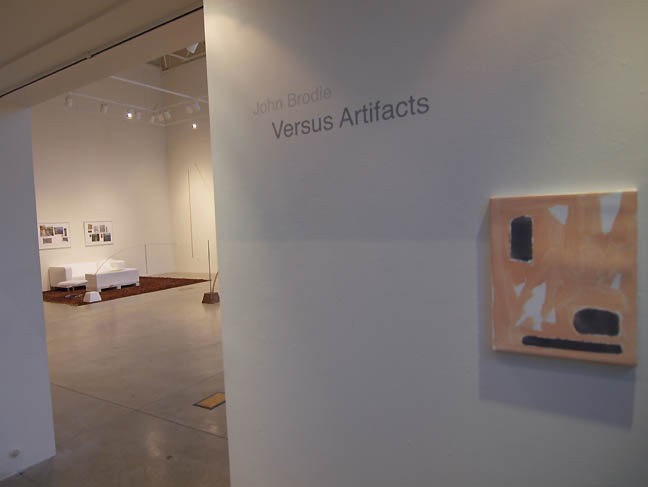 John Brodie at Linfield College with Hello, Welcome (at right) Similarly, John Brodie's Versus Artifacts at Linfield feels less like a shrine and is more of a poetic clearinghouse of objects. As mentioned earlier, making combines out of preexisting stuff has been very popular since Robert Rauschenberg (and we could argue Picasso) but today it is everywhere from Iza Genzken to Rachel Harrison, Carol Bove , Mitzi Pederson and Jessica Jackson Hutchins. Besides these there are many clones. What is interesting about Brodie's take is there is a sense of a reuse, as if these art objects might still be being used for mundane things rather than art in the near future. In particular it is the way Brodie seems to have moved aspects of his home into the gallery rather than moved his studio's contents into an exhibition space. The first hint to this is literally the first piece in the show, a painting called Hello, Welcome. Rather than an archeological dig and presentation of his studio, Brodie decided to play host. The painting reminds me a lot of abstract work in the 40-50's, much like Agnes martin's early work. It is genial with a pleasant composition of solid dark forms floating in a airy sea of orange. It seems to say, "cocktails will be served." 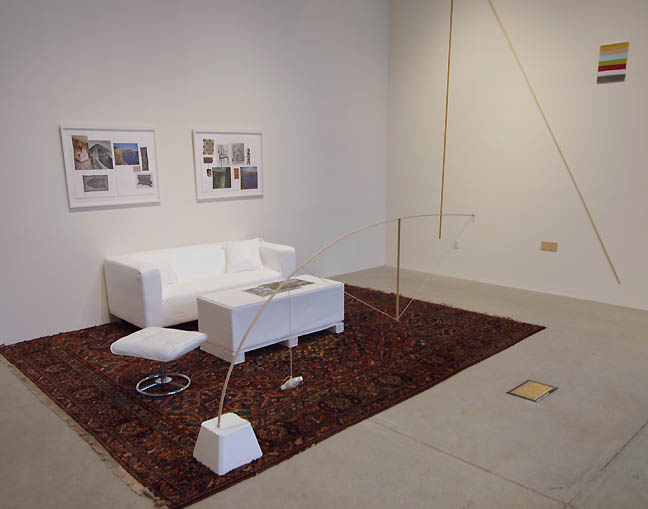
Once inside the space seems a little over full, at first I thought it might have been a mistake but I realized many of the pieces acted simultaneously both as personages and furniture, hence this place has a crowd. The fabrics, wood, and framed work all have a domestic sensibility that has been shifted and there is a white couch conspicuously titled The Lounge on the far end of the space. So, apparently this is a party with Brodie's stuff. Ok, lets mingle. 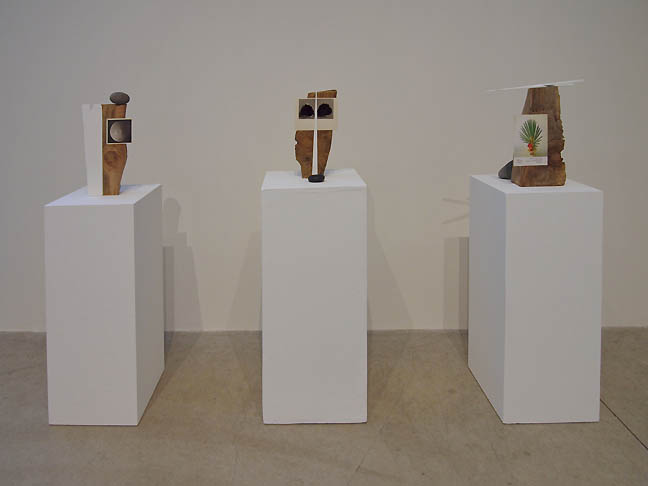 (R to L) Stumps 1-3 As one steps inside the viewer is greeted with 3 pieces on plinths titled Stumps 1-3. Each consists of the promised stump, parts painted white, some kindling and post cards. Stump 1 features the kindling painted white placed atop like chopsticks in a geisha's hair. Stump 2 features a rounded Noguchi-like rock in front and is bisected by the white kindling. Stump 3 features 2 Noguchi/Carl Andre river rocks and is painted half white. Each is poetic, evoking headdresses, ikebana and an attention to fine details (some even have surprises in the back). As a group the function as a lobby or foyer with a little bit of this and that. The use of post cards recall Rachel Harrison's sculptures, which acted as stands for vintage photographs. The difference is the sense that Brodie's pieces on traditional plinths are playing a role in a cast of characters... ok nice to meet you 3 sisters, all very charming and what good taste you have. 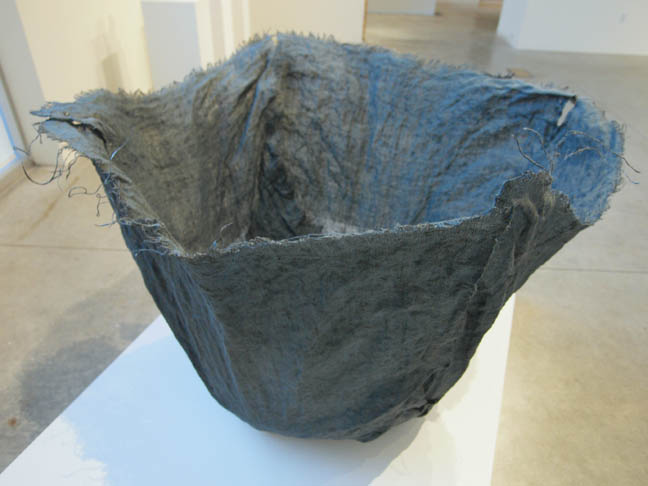 Blue Vessel Which brings us to my favorite work in the show, Blue Vessel. It's a large whirlpool-like cauldron composed of dyed burlap. It holds court like the tastiest food at the party. It's structure alone defies gravity, not unlike a huge salad or dramatic dress which is so fantastic when it appears... that the whole room turns and gasps. The frayed edges themselves take on a drama, not unlike a recent divorcee who is having a few too many to celebrate after an arduously protracted settlement. At this party Blue Vessel is no bore. There is something more here too as it recalls the krater size of a Grecian urn. 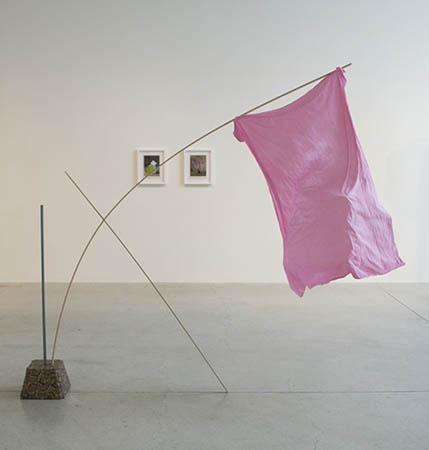
(FG)False Surrender Other pieces like the pink flag waving False Surrender, recall warfare, semaphore and those people who must wave their arms when they speak at parties. Or is it a dance? Is this False Surrender that one person that is gonna dance no matter what anyone else is doing? It reminds me a little too much of Mitzi Pederson's work with long pieces of wood propped and in exquisite tension. Another favorite though is Epoch Rest which features images of several woven textiles printed on glass. This one is cool, leaning against the wall and oozes worldly charm... It is one of the best things I've seen from a Portland artist this year, along with blue vessel. 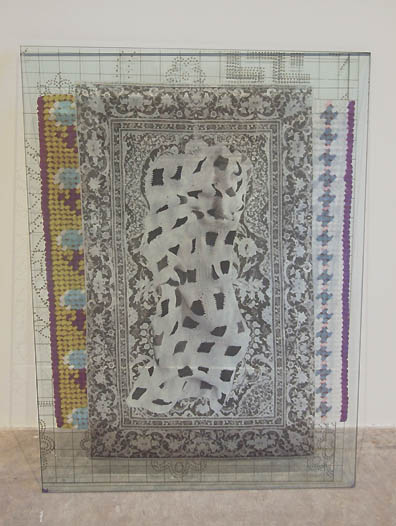 Epoch Rest Other works point you all over the room and have one marveling at the deft decorator's touch such as Red Vessel Linen. With just a little red paint on a vintage image, voila the artifact presented becomes a bit of a Warholian celebrity. Good moves are easy to find in this show but I found the couch too crowded so I headed for the final wall titled See. The wall was covered in more woven designs printed on huge slabs of hexacomb cardboard. Both domestic and gorgeously imposing it also looked like a huge clown's face from afar... I guess that is how that party ended? I does have a somber more personal tone than anything else in the show. 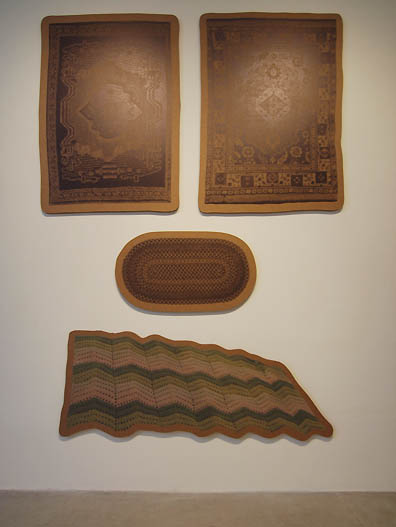 See Somehow, instead of archeological excursion through John Brodie's stuff (which if you have ever been in one of his studios over the years is fascinating) Versus Artifacts became a kind of networking designers cocktail party to my eyes. I think that means it worked? The work in Versus Artifacts was disparate but knowing, super tasteful but insolently everyday. Brodie is one of the most essential people in Portland's cultural scene and I feel like this was a transition show. In the past he did colorful stripe paintings and sculpture, of which this show only has one within a piece called Wall Dreaming No 1., but it feels like he is onto something amazing involving textiles and images of them on improbable materials. As a dynamic duo of exhibitions both D&F Cartier and John Brodie transformed archival objects into very something less remote and very present. It feels like a spring awakening (Wedekind reference intended) and the immediacy seems extremely remote from the art world's current fixation on market value. These two shows remind us of the viewer's role in activating work through experience and the way the artist's choices can make art that experience more beguiling and viscera... generating the only true artifact, one of memory. Today, March 22 is the last day of for Versus Artifacts at Linfield College Posted by Jeff Jahn on March 22, 2014 at 1:09 | Comments (0) Comments Post a comment Thanks for signing in, . Now you can comment. (sign out)
(If you haven't left a comment here before, you may need to be approved by
the site owner before your comment will appear. Until then, it won't appear
on the entry. Thanks for waiting.)
|
| s p o n s o r s |
 |
 |
 |
 |
 |
 |
 |
 |
 |
 |
 |
 |
 |
 |
 |
 |

|
Site Design: Jennifer Armbrust | • | Site Development: Philippe Blanc & Katherine Bovee | |

